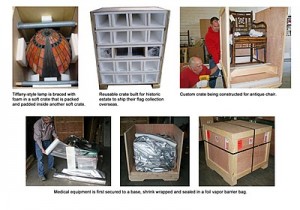 |
| Click photos to enlarge view. |
What IS standard, though, is the need for a sturdy crate that is reinforced for any weight, with a forklift-ready base for transport from warehouse to truck to dock. Crates may be constructed for a one-time use, or they can be built to be reusable, for example for a trade show, where it would be used over and over again.
Inside the crate, the item must be blocked and braced securely to ensure the stability of the item during transport. Packing materials, such as acid free paper and foam for artwork, to heavy duty shrink and bubble roll for larger items, provides further padding and protection. To ensure proper overseas shipping, heat treated (HT ISPM) wood must be used so that your valuable cargo is compliant with international treaties and will not be held up for any reason during export. If your cargo is to be shipped in a sea container and is sensitive to moisture, it should be shrink wrapped and sealed inside a foil vapor barrier bag, which is heat sealed. This will protect your cargo from long-term exposure to the marine environment.
It is important to label your crate with proper identification on all four sides to prevent any chance of loss or misplacement – adhere a large label with the consignee’s name and address as well as your own, and affix labels indicating which side is up and if the crate contains glass or fragile items. Tipping indicators placed inside and on the outside of the crate are further handy indicators to monitor your cargo’s condition while in transit or storage.
Subscribe to Arnoff Moving & Storage's Blog
s






Comments